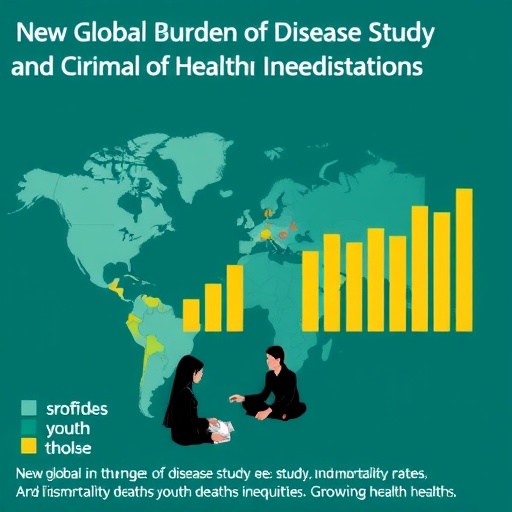In a monumental update to our understanding of global health dynamics, the latest findings from the Global Burden of Disease (GBD) study, published in The Lancet on October 12, 2025, reveal profound shifts in mortality patterns, disease prevalence, and risk factors worldwide. This comprehensive research, supported by the Institute for Health Metrics and Evaluation (IHME) at the University of Washington, utilizes an unprecedented volume of data, incorporating over 310,000 sources and spanning 204 countries and territories, to shed light on health trends from 1950 through 2023. The results illuminate key victories in public health and emerging crises threatening gains made over decades.
The first critical insight emerging from the GBD analysis is the remarkable progress in extending global life expectancy and reducing overall mortality rates. Since 1950, average life expectancy has surged by more than 20 years, with current figures standing at approximately 76.3 years for females and 71.5 years for males. Concomitantly, the age-standardized mortality rate—adjusted to account for population age distributions—has plummeted by 67%. This downward trend in mortality spans all 204 countries and territories evaluated, underscoring the power of sustained improvements in healthcare access, nutrition, vaccination coverage, and disease prevention strategies.
Yet, amidst this optimistic landscape lies a nuanced and concerning divergence in health outcomes among specific age groups and regions. The study highlights an alarming rise in mortality among adolescents and young adults, particularly those aged 20 to 39 in high-income North America, with similar patterns appearing in Latin America. The drivers underpinning these increases are complex, encompassing suicide, drug overdoses, and excessive alcohol consumption, which together form an emerging public health emergency. Additionally, the mortality rate for children aged 5 to 19 has increased in Eastern Europe, high-income North America, and the Caribbean, reflecting vulnerabilities in these cohorts that require urgent policy attention.
Sub-Saharan Africa presents its own set of challenges. Despite the overall improvements in global mortality, children aged 5 to 14 in this region suffer from rates of death higher than previously estimated. The primary causes include respiratory infections, tuberculosis, other infectious diseases, as well as unintentional injuries—conditions closely tied to the region’s persistent healthcare and infrastructure deficits. Moreover, young adult females aged 15 to 29 exhibit particularly high mortality rates, driven by maternal mortality, road traffic injuries, and meningitis — indicators of critical gaps in maternal health services and injury prevention.
These regional disparities are accompanied by a significant epidemiological transition worldwide, moving away from infectious diseases toward non-communicable diseases (NCDs) as the dominant causes of death. Cardiovascular diseases, notably ischemic heart disease and stroke, continue to lead the global mortality causes. While mortality rates for several communicable diseases such as diarrheal illnesses, tuberculosis, and measles have decreased, chronic conditions including diabetes, chronic kidney disease, Alzheimer’s disease, and HIV/AIDS show an upward trend. This shift imposes new burdens on healthcare systems, particularly in low-income countries where resources for NCD management are limited.
In terms of mortality age profiles, average life duration at death globally has risen from 46.4 years in 1990 to 62.9 years in 2023. This increase conceals stark inequities: in high-income regions, females typically die around 80.5 years and males at 74.4 years, whereas in sub-Saharan Africa, the mean ages of death are nearly half as much—37.1 years for females and 34.8 years for males—highlighting the urgent need for targeted interventions in vulnerable populations.
Furthermore, while the overall probability of dying before age 70 has decreased in most regions, an exception lies in the persistent or increasing death rates related to drug use disorders, especially in high-income countries. Similarly, sub-Saharan Africa faces escalating mortality risks from NCDs, where the expected age of death should be higher. These trends reveal shifting disease burdens and point to the increasing complexity of global health challenges.
Central to the GBD findings is the revelation that nearly half of global mortality and morbidity is attributable to 88 modifiable risk factors. Foremost among these are high systolic blood pressure, exposure to particulate matter pollution, tobacco smoking, elevated fasting plasma glucose, adverse birth metrics (low birthweight and short gestation), obesity as indexed by high body mass index (BMI), and high LDL cholesterol. Of these, the age-standardized disability-adjusted life year (DALY) rates attributable to high BMI have increased by nearly 11%, drug use by 9%, and elevated blood sugar by 6% between 2010 and 2023, signaling a worrying pivot toward lifestyle and metabolic risks.
Notably, recent advances in modeling have elucidated the cardiovascular dangers posed by lead exposure, the 10th highest risk factor globally. Despite reductions realized through eliminating lead from fuel sources, lead remains pervasive in certain paints, contaminated soils, water systems, and even traditional cooking utensils, continuing to pose a persistent public health hazard. Public health strategies must therefore address these environmental risks alongside behavioral and metabolic ones.
Environmental factors influenced by climate change, especially air pollution and heat exposure, intensify health burdens regionally and globally. South Asia, sub-Saharan Africa, and North Africa and the Middle East experience the highest DALY rates related to particulate matter pollution, with high temperatures exacerbating vulnerabilities in already fragile areas such as the Sahel. These compounded climatic stresses amplify food insecurity, displacement, and drought-related health impacts, underscoring the convergence of environmental and health crises.
The ongoing escalation in mental health disorders presents another formidable challenge. Anxiety disorders have seen a surge of 63%, and depressive disorders have increased by 26%, illustrating a growing mental health crisis worldwide. Alarmingly, adverse social determinants, including sexual abuse and intimate partner violence, are recognized as significant, preventable contributors to mental illness, demanding integrated psychosocial and public health responses.
Among the youngest populations, risks still revolve heavily around nutrition and environmental exposures. For children under five, maternal and child malnutrition, particulate pollution, and inadequate access to safe water, sanitation, and hygiene (WaSH) remain leading risks for morbidity and mortality. In older children and adolescents aged 5 to 14, iron deficiency emerges as a prime concern, while unsafe WaSH conditions and malnutrition continue to impact health outcomes significantly.
The landscape of health risks evolves with age. For adults between 15 and 49, unsafe sex and occupational injuries dominate, closely followed by metabolic risks such as high BMI and elevated blood pressure. In older adults, aged 50 to 69, high systolic blood pressure leads risk factors, trailed by smoking, elevated blood glucose, and kidney dysfunction, highlighting the need for age-tailored intervention strategies.
Encouragingly, injury-related health loss, as measured by DALYs, has decreased by 16% since 2010. Nonetheless, the burden of injuries disproportionately affects males, particularly adolescents and young adults between 10 and 24 years, who experience more than twice the health loss compared to females in this cohort. These findings advocate for enhanced injury prevention and youth-focused health policies as integral parts of comprehensive global health strategies.
The GBD 2023 report serves as a clarion call for policy makers and health leaders worldwide. While substantial progress has been made in reducing infant mortality and managing infectious diseases, emerging threats to adolescent and young adult health as well as the shift toward chronic non-communicable diseases demand renewed focus and investment. The ongoing cuts in international aid jeopardize advances in low-income regions where healthcare infrastructure remains fragile and dependent on external funding. Without sustained global support, health inequities are likely to widen, reversing decades of hard-won gains.
This unprecedented data-driven insight underlines the critical importance of adaptive, evidence-based health policies to address an increasingly complex global health environment—one marked by demographic shifts, evolving disease spectrums, environmental challenges, and mental health crises. As the world advances into the mid-21st century, the GBD 2023 study provides an indispensable foundation upon which to build resilient health systems capable of reducing premature death and disability while enhancing well-being for all populations.
Subject of Research: Global mortality, disease burden, risk factors, and health disparities from 1950 to 2023
Article Title: Global Burden of Disease Study 2023: Demographic Shifts, Emerging Health Crises, and the Rising Burden of Non-Communicable Diseases
News Publication Date: October 12, 2025
Web References: https://www.healthdata.org/research-analysis/gbd, https://www.thelancet.com/gbd, https://www.worldhealthsummit.org/sessions/1a478f74-47db-44ac-b410-a4b9a2e14f53
Keywords: Mortality rates, Morbidity, Non-communicable diseases, Epidemiological transition, Disability-adjusted life years, Risk factors, Environmental health, Mental disorders, Global health disparities, Adolescents’ health, Infectious diseases, Chronic disease risk
Tags: comprehensive health data analysisdisease prevalence changesGlobal Burden of Disease Studyglobal health trendshealth inequitieshealthcare access disparitieslife expectancy improvementsmortality rate statisticspublic health achievementsrisk factors in healthvaccination coverage impactyouth mortality rates





